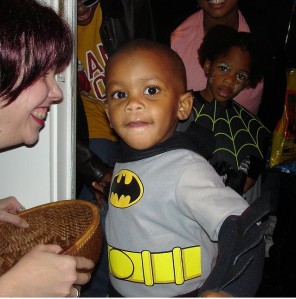118.07.04.17
Wednesday, February 16, 2011
Piano Strings Attached
One of our pianos, our baby grand, needed a string replaced. The combination of a new piano wrench, an initial wrong threading, and a very dusty piano meant three hours of work instead of one. The good news is: Don, our piano tuner, did not charge a penny (he said we were his guinea pigs for his brand-new piano wrench). He did accept a cup of black coffee. He will be back later to tune the piano. BTW, how does ONE note with its broken string result in FOUR, new strings?!
118.07.04.17
118.07.04.17
Monday, February 14, 2011
Surprise from him
My hubby never buys gift baskets. So, when this Ghirardelli basket awaited my return from Piano lesson today, it was a bit of a shock. I called him at work, and at first he says Happy Anniversary; then quickly corrected himself and said Happy Valentine's Day. In answer to my question as to why he purchased the basket, he emphasized that it was on SALE, it was a good deal, they had free shipping, and not to worry about it. So, okay, I won't worry. Russel Stover from AJ. We'll have great dessert tonight!
Friday, February 11, 2011
Deindividuation
Deindividuation
The Misconception: People who riot and loot are scum who were just looking for an excuse to steal and be violent.
The Truth: You are are prone to losing your individuality and becoming absorbed into a hivemind under the right conditions.
When a crowd gathers near a suicidal jumper something terrible is unleashed.
In Seattle in 2001, a 26-year-old woman who had recently ended a relationship held up traffic for a little too long as she considered the implications of leaping to her death. As motorists began to back-up on the bridge and become irate, they started yelling “Jump, bitch, jump!” until she did.
Cases like this aren’t unusual.
In 2008, a 17-year old man jumped from the top of a parking garage in England after 300 or so people chanted for him to go for it. Some took photos and recorded video before, during and after. Afterward, the crowd dispersed, the strange spell broken. The taunters walked away wondering what came over them. The other onlookers vented their disgust into social media.
In San Francisco, in 2010, a man stepped onto the ledge of his apartment window and contemplated dropping from the building. A crowd gathered below and soon started yelling for him to jump. They even tweeted about it. He died on impact fifteen minutes later.
“i was there and im traumatized. the guys next to me were laughing telling him to jump and videotaping the whole thing. i’m still young and in high school and this is gunna stick with me for the rest of my life. there was a total lack of respect for the poor man and people were laughing when he jumped.”
- comment left at the SF Examiner
Police and firefighters are well aware of this tendency for crowds to gather and taunt, and this is why they tape off potential suicide scenes and get the crowd out of shouting distance. The risk of a spontaneous cheering section goading a person into killing themselves is high when people in a group feel anonymous and are annoyed or angry. It only takes one person to get the crowd going. Those are the three ingredients – anonymity, group size and arousal. If you lose your sense of self, feel the power of a crowd and then get slammed by a powerful cues from the environment – your individuality may evaporate.
Many people who witnessed these events felt terrible about what happened and condemned the people who encouraged the jumpers, going so far as to condemn humanity itself after seeing such a dark display. What they didn’t realize, and what the people yelling didn’t anticipate, was the predictability and regularity of their behavior.
This is going to be hard to believe, but this sort of behavior could be inside you as well. Under the right circumstances, you too might yell “Jump!” To understand why, let’s go shopping for costumes.
Halloween is a fantastic playground for cultural norms to clash and crack. Costumes and candy, parents and children, the revelry and irreverence directed toward evil and death and hauntings – it is a day to pull back from standards, the rules of proper and normal behavior, and experiment with surrogate selves.
The tradition is observed around the world now, not just in Western and European countries. From Japan to India to Australia, people recede into anonymity and become absorbed by characters who will be shed the next day. Halloween is fun because it feels good to drop the heft of your flesh-and-blood identity from time to time no matter how old you are. The fantasy is something kids wearing clown shoes in pursuit of candy bars and adults shifting aside Guy Fawkes masks to accommodate Jager shots can both appreciate.
Halloween isn’t Mardi Gras or Carnival where just about anything goes, but it is truly the only holiday in the United States where everyone agrees to tilt their heads and let a giant swath of weird things slide. You can pretend to be Don Juan on Valentine’s Day, but you can’t dress like him in public without risking a photo landing on Reddit.
A great costume can draw attention to the garments of individuality you wear every other day simply by replacing them. Halloween gives you an opportunity to play around with the roles, labels and characters we all know are in some ways fabrications, mutually accepted fibs required to get by in a complex social game. The mask you wear to work or to a family reunion or out on a first date is not so much different from the one you wear heading out to plead for Snickers or dance to digital mixtapes.
These shades of self you’ve molded and honed over the years started out awkward and blunt, obvious and tacky. As you approached adolescence you tried on a variety of personae until one fit. You may have pierced body parts or tattooed areas you could cover up when needed. You may have picked out some celebrity or fictional character and cherry picked from their wardrobe, stealing a bit of their magic in the hope you could add it to yours.
Through each season of your life, you sharpen your image and polish your patina until you have a sense of the individual you claim to be.
Still, it’s always fun to role-play and hit reset, and Halloween is one of the few widely accepted times you get to do this in front of everyone you know. In many ways, it is a holiday celebrating anonymity through experimentation with individuality.
It was this muted sense of self which, in the late 1970s, led a group of psychologists to turn Halloween into a controlled study of the human mind.
Arthur Beaman, Edward Diener and Soren Svanum travelled to a nice neighborhood in Seattle, Washington, and picked out 27 homes which would become makeshift laboratories. The researchers wanted to see if the anonymity of Halloween costumes would affect the behavior of children as they gallivanted from secret lab to secret lab.
The researchers placed inside the entrance to each home a bowl of candy, a mirror and a festive Halloween decoration in which a scientist watched through a peephole as children arrived throughout the night. Yes, it was a bit creepy. Unfortunately, there wasn’t a side study into how difficult it would be to hold back the urge to leap out and scream at the children while wearing a labcoat and waving a clipboard.
A woman greeted children throughout the night, and when the tykes presented their trick-or-treat bargains she told them each could have only one piece of candy. She then walked away, leaving them to sort out their tiny moral codes. Half of the time the woman at the door asked the children to say their names and where they lived before leaving them. If the children arrived with adults, they were omitted from the results. The psychologists wondered if the kids would take only one piece thinking there were no adults around to exact punishment or express disappointment in their gluttony. Would they react differently when alone or in groups? Would saying their names remind them of the people behind the masks? Once the kids were primed to remember their identity, or if they saw their reflection in the mirrors, would it remind them of who they were?
In the end, the mirror wasn’t the determining factor. What made the most difference was whether or not they had said their names and whether or not they were alone or in a group.
If they had to say their name and were also alone, less than 10 percent of children cheated. In a group, about 20 percent of those who revealed their identity disobeyed the host. More of the anonymous children stole candy when alone – 20 percent. In a group, close to 60 percent of the anonymous stole the candy. The results suggested the power of their anonymity was magnified in the presence of others. Left unmasked, the cheating rose a bit in a group. With the masks on, it was turbocharged. The kids who felt most anonymous and the most protected by the shared anonymity of the group were also the most likely to break the rules and take more candy. With anonymity set to maximum, many kids tried to take all the candy they could.
This study is one of many which shows your identity can spring a leak in the presence of others, and the more others there are, the more you dissolve into the collective will of the group. Looting, rioting, lynchings, beating, war, chasing a monster with torches – the switch is always there, and it doesn’t take much to flip it.
Psychologists call this phenomenon deindividuation, it’s fun to say and one of the more straightforward terms in the scientific lexicon. In certain situations, you can expect to be de-individualized. Unlike conformity, in which you adopt the ideas and behaviors of others for acceptance and inclusion, deindividuation is mostly unconscious and more likely to lead to mischief. As psychologist David G. Myers said, it is “doing together what you would not do alone.”
Think back to when you got into the most trouble as a teenager, or maybe even beyond those years. Chances are, you were in a group and became seduced by the collective will of your peers. There may have been influencers, instigators or natural leaders, but in the end everyone in your circle probably dissolved into the mind of the unit. When the principle, parent or police asked, “What were you kids thinking?” you had no answer because there wasn’t one. You were just reacting, moving as a herd.
In 1969, psychologist Phillip Zimbardo had female college students deliver painful electric shocks to other female students. Half of the students giving the shocks were randomly selected to wear big hoods and roomy lab coats during the experiment in addition to numbered tags. The other half remained unmasked and wore tags revealing their names. He told the soon-to-be torturers he was studying creativity under stress, and as a woman on the other side of a one-way mirror took a test they were to deliver shocks to see if it affected her performance. The women riding the lightning were actually actors and only pretended to writhe in agony.
Zimbardo made sure the subjects knew it was going to hurt by giving each one a 75-volt sample of pain. In addition, to provide motivation, he had the subjects watch a taped interview with the two test-takers in which one seemed friendly and sweet, but the other was rude and mean.
Zimbardo didn’t tell the girls in either group, masked and unmasked, how often to zap the test takers or for how long. They didn’t have to shock at all if they didn’t want to. They also didn’t talk to each other during the experiment. He wanted to eliminate as best he could obedience to authority and peer pressure. The only factors in play were anonymity and deindividuation. In groups of four, the students sat down and began to torment the test takers.
In each run of the experiment, the women hidden behind hoods and lab coats shocked the test takers twice as often. It didn’t matter if they seemed nice or mean, each actor got just as much juice from the hooded women. The shocks even got more frequent and lasted longer as the test continued. All the while, the actors pretended to be in terrible pain on the other side of the mirror.
The women whose faces could be seen shocked the nice actor less than the unpleasant one, and this according to Zimbardo was the most interesting finding. The deindividuation, the anonymity afforded by the hoods, allowed a terrible behavior usually held back by social norms to run free without any regard for fairness or justice. Without consequences, the excitement of having control over another person fed on itself. As Zimbardo said, the escalation was driven by a positive-feedback loop of arousal. The more they shocked, the more excited they got. The more excited they got, the more often they shocked. Although no one in the experiment refrained from shocking the test-takers, those who weren’t masked made a distinction between the woman who deserved to get her comeuppance and the one who didn’t.
Strangely enough, this same experiment was conducted with Belgian soldiers, and when they wore the hoods they shocked the test-takers less. In their case the uniforms they already wore promoted deindividuation, but the hoods isolated them. Among other soldiers they were part of a unit, a group. Under the hood, they were one person again.
“The banality of evil shares much with the banality of heroism. Neither attribute is the direct consequence of unique dispositional tendencies; there are no special inner attributes of either pathology or goodness residing withing the human psyche or the human genome.”-Phillip Zimbardo from his book “The Lucifer Effect”
Zimbardo conducted another experiment, and like the Seattle researchers he used the wonderful built-in anonymity of Halloween as a tool. He observed as elementary-school children played games to win tokens which they could turn in at the end to earn prizes. The kids had a choice of games to play. Some games were competitive but non-aggressive while others were one-on-one duels like extracting a beanbag from a tube. The children played these games at a Halloween party both in and out of costume. The teacher told the children the costumes were on their way during the first round, and when they supposedly arrived the kids competed again with their identities concealed. Once the competition was over, the teachers said another class needed the costumes, so they went through the games one more time unmasked. The amount of time the children spent playing the aggressive games, pushing and shoving and yelling, doubled once the costumes were on going from 42 percent to 86 percent. When they came off, it dropped back to 36 percent. When in costume, under the spell of deindividuation, they wanted to go head-to-head and fight even though those games took longer and yielded far fewer tokens. As soon as the costumes were removed, they returned to more civil behavior.
Every time you wade into a crowd or don a concealing garment, you risk deindividuation, and it often brings out the worst in you. When you step back and see yourself as the perpetrator, you act as though your reputation and position in society is at stake. When you have no identity, when you are nameless, faceless and free from retribution, the chains of inhibition fall from your brain.
What hides inside you, held back by inhibition, and how would it manifest if freed? Would you yell for someone to jump to their death while tweeting about it and taking photos? Sitting there now, you think there is no way you could do such a thing, but right now you are an individual with social chains binding both the darkest evil and the brightest good in your heart. You can’t truly predict what would happen if the three ingredients of deindividuation were added to your consciousness – anonymity, group size and arousal.
Super arousal can come from a stirring speech, a mind-melting concert with an intense light show, a dangerous enemy pressing forward on your position or any number of things which get your attention and then won’t let it go. Chanting, singing, dancing and other ritualistic, repetitive group activities are particularly effective at focusing your attention and distracting you from the boundaries of your head and body. Your focus and emotional response builds and builds until the fragile container holding your persona shatters, and not only do your emotions diffuse among the many, but so do your morals and sense of responsibility toward your actions. You no longer feel accountable for your deeds, good or bad, but instead imagine a future in which the group will be praised or blamed for what you did together. It is at this point when you feel fully anonymous. The finely crafted individuality you usually enjoy is suppressed, and the cues from your environment steer you and the others in your group. If you are at Woodstock in 1969, you may feel saturated with love and belonging and come away from the experience with a sense of wonder and joy in addition whatever else you end up putting in your body. If you are at Woodstock in 1999, you may feel enraged and aggressive and come away from the experience with broken ribs and a felony conviction. In each situation, a giant crowd of people followed the natural path to deindividuation. They became super aroused, lost their selves and then went with the cues from their environment.
Deindividuation is usually promoted in any organization where it is important to reduce inhibition and get you to do things you might not do alone. Soldiers and police don uniforms, warriors wear paint, football players wear jerseys, gangs have colors and dances and rituals. Businesses spend millions on team building in an effort to instill a deindividualized sense of worth. Parties thrown by fraternities and sororities have more potential to get out of hand than a party where no one feels absorbed by a group or protected by its norms.
Deindividuation takes away your inhibitions as well as your sense of self and fear of accountability, but this isn’t necessarily a bad thing. The same force which brings otherwise rational people to loot and vandalize and invade Poland can also lead to prosocial behaviors. If you are surrounded by positive cues, deindividuation could lead you to work harder in an exercise class, or pitch in at a homeless shelter, or help build a house. People who forget their sense of self and work together to save a life or search for a missing child show deindividuation is a neutral force of the human will. When 4Chan or Digg or Reddit assemble into an anonymous collective to exact revenge it often ends in actual justice. Once deindividuation kicks in, the cues from the environment shape the resulting behavior. The norms of the mob, good or evil, replace the norms of everyday life.
Robert D. Johnson at Arkansas State and Leslie Downing showed in 1979 how manipulating environmental cues could change the behavior of deindividualized people. Their study was much like Zimbardo’s in which subjects were instructed to shock other people trying to learn a task. In their study, the people delivering the shocks wore either Ku Klux Klan robes or nurse’s uniforms. The subjects in the KKK costumes shocked more than control groups, and those in nurse’s uniforms shocked less. Psychologists Steven Prentiss Dunn and C. B. Spivey showed in a series of studies in the late ‘80s and early ‘90s a deindividualized person could be swayed to donate more money than normal if the cues in their environment were prosocial. The deindividuation which occurs at the Super Bowl, the church sermon, the prison riot and the revolutionary uprising is the same – the behavior which follows is not.
Keep in mind how prone you are to deindividuation and in what situations you are most susceptible to it. Anything from binge drinking to singing Baptist hymnals can decrease your awareness of self. Add to this the diffusion of responsibility and anonymity which comes from being within a group, living in a large city, sitting in a darkened room or wearing a mask, and all it takes is a heightened state of arousal for you to become permeable, vulnerable to whatever cues grab your attention.
 Know too that chat rooms, comment threads and message boards are perfect breeding grounds for deindividuality. The more anonymity a user is allowed, the more powerful the effect of being protected by the group. The tone and tenor of the conversations therein and the meatspace ramications of their collective efforts will reflect the cues provided by the website.
Know too that chat rooms, comment threads and message boards are perfect breeding grounds for deindividuality. The more anonymity a user is allowed, the more powerful the effect of being protected by the group. The tone and tenor of the conversations therein and the meatspace ramications of their collective efforts will reflect the cues provided by the website.
Deindividuation pervades virtual worlds, and the results are mixed. Download “Second Life” and take a stroll. Sooner or later you’ll end up in a sex dungeon. Play any game on Xbox Live, and someone will eventually claim to have carnal knowledge of your mother. You can thank anonymity and deindividuation for both. The comments under a Youtube video may make you weep for the species, but just click over to the entry on the humanzee in Wikipedia for restoration. It is consistent with the world outside the machine. The same force which built and maintained concentration camps also pushed soldiers onto Omaha Beach.
If you want to promote deindividuation for a good cause either in the analog world or a digital one, help people in your group feel safe from judgment and provide prosocial cues. If instead you want to discourage deindividuation in yourself and others, you must eliminate anonymity and avoid dehumanizing labels. The more you feel personal accountability, the more restraint you will show. (emphasis by blog owner)
If nothing else, remember if you want to throw a badass party where inhibitions fade and hijinks ensue, turn down the lights, turn up the music and, if appropriate, wear costumes.
by David McRaney
Feb 10, 2011
http://youarenotsosmart.com/2011/02/10/deindividuation/
74.8.23.18
Wednesday, February 9, 2011
How timely is this?
Miss L. only has a handful of Preparatory Music students; she has many more Suzuki students. The time for the Music School's Preparatory Contest was at hand, and Jillian was IT in the Senior Division. The last time one of Ms Lim's students entered the contest, he had also won (Kevin, 2 years ago). We were in need of the prize money, and we prayed for God's help. He had helped us 4 years previously, when Jill won 1st place in the Junior Division.
Contestants (Senior Division):
1st -- Cello/Piano by Ester
2nd -- Piano by Jill, Tempest Sonata by Beethoven
3rd -- Violin by Sajani, Concerto # 9 by De Beriot
4th -- Piano by Luke, Tales from Hungary by Martha Mier
Jillian Won 1st Place!
Praise God!!
Sajani won 2nd Place!
...this is the Violin piece, though played by someone else on youtube:
">
Contestants (Senior Division):
1st -- Cello/Piano by Ester
2nd -- Piano by Jill, Tempest Sonata by Beethoven
3rd -- Violin by Sajani, Concerto # 9 by De Beriot
4th -- Piano by Luke, Tales from Hungary by Martha Mier
Jillian Won 1st Place!
Praise God!!
Sajani won 2nd Place!
...this is the Violin piece, though played by someone else on youtube:
">
Saturday, February 5, 2011
Friday, February 4, 2011
BBC's top 100 books --- books read recently
Must add these to my list of books I've read recently.
A couple are not in their top 100 books list:
The Time Traveler’s Wife - Audrey Niffenegger (done 12/23/2010)
The Curious Incident of the Dog in the Night - Mark Haddon
Mennonite in a Little Black Dress - Rhoda Janzen
The Things they carried - Tim O-Brien
The Da Vinci Code - Dan Brown (done 1/18/2011)
My Journey with Farrah - Alana Stewart (done 1/20/2011)
The Poisonwood Bible - Barbara Kingsolver (done 1/24/2011)
A Tale of Two Cities - Charles Dickens (done 1/30/2011)
Battle Hymn of the Tiger Mother - Amy Chua (done 2/3/2011)
A couple are not in their top 100 books list:
The Time Traveler’s Wife - Audrey Niffenegger (done 12/23/2010)
The Curious Incident of the Dog in the Night - Mark Haddon
Mennonite in a Little Black Dress - Rhoda Janzen
The Things they carried - Tim O-Brien
The Da Vinci Code - Dan Brown (done 1/18/2011)
My Journey with Farrah - Alana Stewart (done 1/20/2011)
The Poisonwood Bible - Barbara Kingsolver (done 1/24/2011)
A Tale of Two Cities - Charles Dickens (done 1/30/2011)
Battle Hymn of the Tiger Mother - Amy Chua (done 2/3/2011)
Wednesday, February 2, 2011
Birthday, Snowday, Happy Day!
It seemed terrible yesterday afternoon, with the high winds and whiteout-conditions. But today, it's hubby's birthday, he has a day off from work, the snow has stopped, the sun is out, and the children are having FUN! What more could one ask??
 |
| Son shoveling us out of our driveway this a.m. |
 |
| Jared & Mr Bubbles |
 |
| a LOT of snow! |
 |
| AJ & Farrah also helping-out |
 |
| GROOVE-y |
 |
| Why?? |
Subscribe to:
Posts (Atom)
-
CONSERVATIVES BELIEVE THEIR LIVES ARE MORE MEANINGFUL THAN LIBERALS, STUDY FINDS ( independent.co.uk ) A new study suggests liberals may...
-
Chianti pointers I learned as an alcoholic-beverage Newbie (or Noobie per JSE) from J & N's friend, Christopher, during their Ne...
-
Happy Birthday, Brigitte Nielsen! The Danish actress (born 15 July 1963 ) and her hubby, Mattia Dessi, welcomed a baby girl in...













